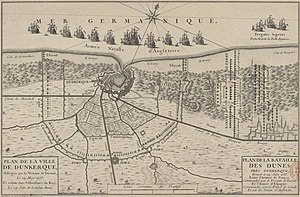| Siege of Dunkirk | |||||||
|---|---|---|---|---|---|---|---|
| Part of the Franco-Spanish War and Anglo-Spanish War | |||||||
 Map showing the Siege of Dunkirk and the Battle of the Dunes with the blockade of the English fleet in 1658 | |||||||
| |||||||
| Belligerents | |||||||
|
|
| ||||||
| Commanders and leaders | |||||||
|
|
| ||||||
| Strength | |||||||
|
12,000 infantry 8,000 cavalry 18 warships |
2,200 infantry 700-800 cavalry | ||||||
| Casualties and losses | |||||||
| 1,600-1,700[1] | |||||||
The siege of Dunkirk in 1658 was a military operation by the allied forces of France and Commonwealth England intended to take the fortified port city of Dunkirk, Spain's greatest privateer base, from the Spanish and their confederates: the English royalists and French Fronduers. Dunkirk (Dutch for 'Church in the dunes') was a strategic port on the southern coast of the English Channel in the Spanish Netherlands that had often been a point of contention previously and had changed hands a number of times. Privateers operating out of Dunkirk and other ports had cost England some 1,500 to 2,000 merchant ships in the past year.[2] The French and their English Commonwealth allies were commanded by Marshal of France Turenne. The siege would last a month and featured numerous sorties by the garrison and a determined relief attempt by the Spanish army under the command of Don Juan of Austria and his confederate English royalists under Duke of York and rebels of the French Fronde under the Great Condé that resulted in the battle of the Dunes.
- ^ Ramsay 1735, p. 188.
- ^ Rodger 2004, p. 28.
© MMXXIII Rich X Search. We shall prevail. All rights reserved. Rich X Search
